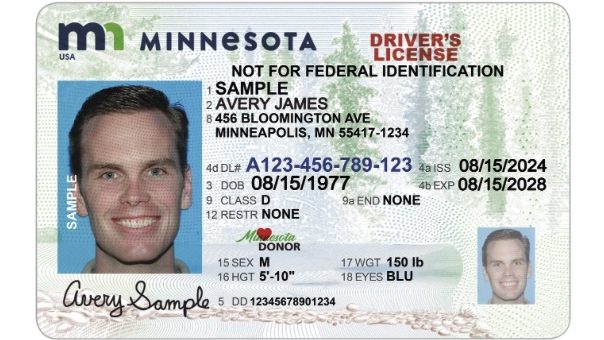If you’ve dreamed of going to the department of motor vehicles and walking away with a new license in hand, get used to holding on to your papers and clipped ID for a few weeks.
Dakota County has announced it will pull out of a pilot program at the license center in Lakeville that offers same-day issuance of standard Minnesota driver’s licenses.
Dakota County’s Lakeville License Center is stepping away from a pilot program issuing in-person IDs. (Courtesy of the Department of Public Safety Driver and Vehicle Services)
The last day in Lakeville will be Oct. 31. The program will continue at the license service center in Moorhead.
The pilot program began in October 2022 through an appropriation from the State Legislature, a rebuke to common complaints from those who have previously lived in other states — “if North Dakota can get this right, why can’t we?” — but it was reportedly fraught with issues.
The Department of Public Safety’s Driver and Vehicle Services reported that more than 74,000 IDs were issued at the Lakeville and Moorhead centers, but almost 40 percent of cardholders eventually replaced them with a traditional card or allowed the ID to expire.
In January 2024, DVS recommended against expansion of the pilot program.
The most telling issue? The in-person IDs differed in quality from the centrally issued counterparts. This reportedly became an issue for customers when they needed to present identification — ordering a drink at a bar, renting a car, completing business at a bank branch or going through security while boarding a flight. At least three people reported that their IDs were rejected by Transportation Security Administration officers.
Department of Vehicle Services Director Pong Xiong said the centrally issued IDs are printed out of a much larger facility than the over-the-counter licenses. This allows the traditional IDs to have a higher quality, printed at a higher capacity.
Xiong said the state tried to find a printing solution that produced a card as close as possible to the centrally printed one, but differences remained.
The in-person IDs look different, and the laminate feels different to the touch, Xiong said. That became a clear problem for an identification credential that is expected to be universal in a world where fakes are commonplace.
A comparison of a same-day license, left, and traditional. (Courtesy of the Department of Public Safety Driver and Vehicle Services)
It led DVS to eventually report the differences on its website. Among the differences on the over-the-counter ID:
The ghost image of the ID holder photo is in color, rather than black and white.
There is no canoeist on the bottom.
The date of birth appears on the card only once.
Issue date cannot be before Oct. 1, 2022.
Location of the shoreline on the background appears vertically on under 21 cards, not at the bottom.
“I think if you are looking at the cards, it would be fairly obvious that they are not exactly the same,” Xiong said.
The same-day pilot program does not issue more intensive identifications such as Real ID, enhanced driver’s licenses or commercial driver’s licenses. Since May 7, travelers have been required to use a certified Real ID driver’s license or identification in order to use it to board a plane.
When DVS reported findings to the Legislature in 2024, they noticed that only seven states provided over-the-counter credentialing, down more than 50 percent from 2014.
Related Articles
As Stillwater wrestles with cannabis shop locations, what are other east metro cities seeing?
Eagan: Omni Viking Lakes Hotel marks 5 years with expansion plan
Voters to decide school levy referendums in Ramsey, Dakota, Washington counties
Man admits to sneaking into woman’s Eagan apartment, raping her
$1B Rosemount aerospace complex, University of St. Thomas semiconductor hub receive state funding
Xiong said he is not surprised to see more states moving back toward a centrally issued solution. In addition to printing quality, he said, using centrally issued identification allows the state time to certify that the information is correct, and that the ID is valid. While those weeks waiting are a point of frustration for customers, the period between application and issuance allows the state another control against fraud prevention, as the process certifies that the address requested by the customer is legitimate.
Xiong said the pilot program currently has no end date and local service centers decide whether to participate.
Calls to the Clay County Department of Motor Vehicles regarding the future of the program in Moorhead were not returned by press time.


Leave a Reply